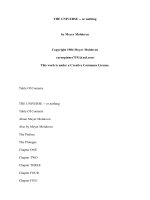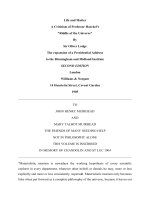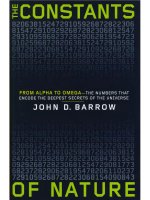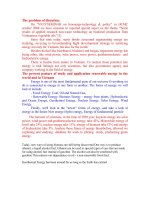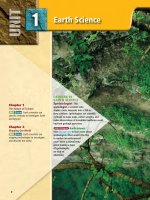- Trang chủ >>
- Đại cương >>
- Kinh tế vĩ mô
fusion the energy of the universe
Bạn đang xem bản rút gọn của tài liệu. Xem và tải ngay bản đầy đủ của tài liệu tại đây (4.65 MB, 225 trang )
Fusion
The Energy of the Universe
WHAT IS THE COMPLEMENTARY SCIENCE SERIES?
We hope you enjoy this book. If you would like to read other quality science
books with a similar orientation see the order form and reproductions of the front
and back covers of other books in the series at the end of this book.
The Complementary Science Series is an introductory, interdisciplinary, and
relatively inexpensive series of paperbacks for science enthusiasts. The series
covers core subjects in chemistry, physics, and biological sciences but often from
an interdisciplinary perspective. They are deliberately unburdened by excessive
pedagogy, which is distracting to many readers, and avoid the often plodding
treatment in many textbooks.
These titles cover topics that are particularly appropriate for self-study although
they are often used as complementary texts to supplement standard discussion
in textbooks. Many are available as examination copies to professors teaching
appropriate courses.
The series was conceived to fill the gaps in the literature between conventional
textbooks and monographs by providing real science at an accessible level, with
minimal prerequisites so that students at all stages can have expert insight into
important and foundational aspects of current scientific thinking.
Many of these titles have strong interdisciplinary appeal and all have a place on
the bookshelves of literate laypersons.
Potentialauthorsareinvitedtocontactoureditorialoffice:
Feedback on the titles is welcome.
Titles in the Complementary Science Series are detailed at the end of these pages.
A 15% discount is available (to owners of this edition) on other books in this
series—see order form at the back of this book.
Physics
Physics in Biology and Medicine, 2nd Edition; Paul Davidovits, 0122048407
Introduction to Relativity; John B. Kogut, 0124175619
Fusion: The Energy of the Universe; Garry McCracken and Peter Stott,
012481851X
Chemistry
The Physical Basis of Chemistry, 2nd Edition; Warren S. Warren, 0127358552
Chemistry Connections: The Chemical Basis of Everyday Phenomena,
2nd Edition; Kerry K. Karukstis and Gerald R. Van Hecke, 0124001513
Fundamentals of Quantum Chemistry; James E. House, 0123567718
Introduction to Quantum Mechanics; S. M. Blinder, 0121060519
Geology
Earth Magnetism; Wallace Hall Campbell, 0121581640
www.books.elsevier.com
This Page Intentionally Left Blank
Fusion
The Energy of the Universe
Garry McCracken
and
Peter Stott
Amsterdam Boston Heidelberg London New York Oxford
Paris San Diego San Francisco Singapore Sydney Tokyo
Acquisition Editor: Jeremy Hayhurst
Project Manager: Troy Lilly
Editorial Assistant: Desireé Marr
Marketing Manager: Linda Beattie
Cover Design: Eric DeCicco
Composition: Cepha Imaging Private Limited
Interior Printer: Hing Yip Printing Company
Elsevier Academic Press
200 Wheeler Road, Burlington, MA 01803, USA
525 B Street, Suite 1900, San Diego, California 92101-4495, USA
84 Theobald’s Road, London WC1X 8RR, UK
This book is printed on acid-free paper.
Copyright © 2005, Elsevier Inc. All rights reserved.
No part of this publication may be reproduced or transmitted in any form or by any means,
electronic or mechanical, including photocopy, recording, or any information storage and
retrieval system, without permission in writing from the publisher.
Permissions may be sought directly from Elsevier’s Science & Technology Rights
Department in Oxford, UK: phone: (+44) 1865 843830, fax: (+44) 1865 853333, e-mail:
You may also complete your request on-line via the Elsevier
homepage (), by selecting “Customer Support” and then “Obtaining
Permissions.”
Library of Congress Cataloging-in-Publication Data
McCracken, G. M.
Fusion : the energy of the universe / Garry M. McCracken and Peter Stott.
p. cm. – (Complementary science series)
Includes bibliographical references and index.
ISBN 0-12-481851-X (pbk. : acid-free paper)
1. Nuclear fusion. I. Stott, P. E. (Peter E.) II. Title.
III. Series.
QC791.M33 2004
539.7
64–dc22
2004011926
British Library Cataloguing in Publication Data
A catalogue record for this book is available from the British Library
ISBN: 0-12-481851-X
For all information on Elsevier Academic Press Publications visit our Web site at
www.books.elsevier.com
Printed in the United States of America
040506070809987654321
To Pamela and Olga,
Thank you for your encouragement and your patience.
This Page Intentionally Left Blank
Contents
Foreword xv
Preface xvii
Acknowledgments xix
1 What Is Nuclear Fusion? 1
1.1 The Alchemists’ Dream 1
1.2 The Sun’s Energy 2
1.3 Can We Use Fusion Energy? 3
1.4 Man-Made Suns 3
1.5 The Rest of the Story 4
2 Energy from Mass 7
2.1 Einstein’s Theory 7
2.2 Building Blocks 8
2.3 Something Missing 12
3 Fusion in the Sun and Stars 17
3.1 The Source of the Sun’s Energy 17
3.2 The Solar Furnace 19
3.3 Gravitational Confinement 20
3.4 The Formation of Heavier Atoms 24
3.5 Stars and Supernovae 26
4 Man-Made Fusion 33
4.1 Down to Earth 33
4.2 Getting It Together 36
4.3 Breaking Even 41
ix
x Contents
5 Magnetic Confinement 47
5.1 The First Experiments 47
5.2 Behind Closed Doors 52
5.3 Opening the Doors 55
5.4 ZETA 58
5.5 From Geneva to Novosibirsk 59
6 The Hydrogen Bomb 61
6.1 The Background 61
6.2 The Problems 63
6.3 Beyond the “Sloyka” 66
7 Inertial-Confinement Fusion 69
7.1 Mini-Explosions 69
7.2 Using Lasers 72
7.3 Alternative Drivers 81
7.4 The Future Program 86
8 False Trails 87
8.1 Fusion in a Test Tube? 87
8.2 Bubble Fusion 91
8.3 Fusion with Mesons 92
9 Tokamaks 95
9.1 The Basics 95
9.2 Instabilities 96
9.3 Diagnosing the Plasma 100
9.4 Impurities 102
9.5 Heating the Plasma 106
10 From T3 to ITER 111
10.1 The Big Tokamaks 111
10.2 Pushing to Peak Performance 115
10.3 Tritium Operation 118
10.4 Scaling to a Power Plant 119
10.5 The Next Step 123
10.6 ITER 125
11 Fusion Power Plants 129
11.1 Early Plans 129
11.2 Fusion Power Plant Geometry 129
11.3 Magnetic-Confinement Fusion 131
11.4 Inertial-Confinement Fusion 133
11.5 Tritium Breeding 137
Contents xi
11.6 Radiation Damage and Shielding 138
11.7 Low-Activation Materials 141
12 Why We Need Fusion Energy 145
12.1 World Energy Needs 145
12.2 The Choice of Fuels 146
12.3 The Environmental Impact of Fusion Energy 150
12.4 The Cost of Fusion Energy 152
Epilogue 155
Units 157
Glossary 161
Further Reading 177
Index 181
This Page Intentionally Left Blank
Technical Summaries
These technical summaries, contained in shaded boxes, are supplements to the
main text. They are intended for the more technically minded reader and may be
bypassed by the general reader without loss of continuity.
Chapter 2
2.1 The Mass Spectrograph 11
Chapter 3
3.1 The Neutrino Problem 21
3.2 The Carbon Cycle 22
3.3 Cosmic Microwave Background Radiation 25
3.4 The Triple Alpha Process 27
3.5 Heavier Nuclei 28
Chapter 4
4.1 Source of Deuterium 34
4.2 Tritium Breeding Reactions 36
4.3 Conditions for Confinement 44
Chapter 5
5.1 Magnetic Confinement 49
5.2 Toroidal Confinement 54
5.3 Linear Confinement 57
Chapter 7
7.1 Conditions for Inertial Confinement 71
7.2 Capsule Compression 72
7.3 The Laser Principle 74
xiii
xiv Technical Summaries
7.4 Capsule Design 82
7.5 Fast Ignition 83
Chapter 8
8.1 Electrolysis 89
Chapter 9
9.1 Disruptions 98
9.2 Sawteeth 99
9.3 Operating a Tokamak 100
9.4 Temperature Measurement 101
9.5 Sources of Impurities 103
9.6 Impurity Radiation 104
9.7 Production of Neutral Heating Beams 107
9.8 Radio Frequency Heating 108
9.9 L and H Modes 109
Chapter 10
10.1 Operating Limits 116
10.2 Pulse Length and Confinement Time 117
10.3 Understanding Confinement 121
10.4 Empirical Scaling 122
Chapter 11
11.1 Shielding the Superconducting Coils 132
11.2 Power Handling in the Divertor 134
11.3 Driver Efficiency and Target Gain 136
11.4 Tritium Breeding 137
11.5 Choice of the Chemical Form of Lithium 138
11.6 Alternative Fuels 139
11.7 Radiation Damage 140
11.8 Low Activation Materials 142
Foreword
Fusion powers the stars and could in principle provide almost unlimited, envi-
ronmentally benign, power on Earth. Harnessing fusion has proved to be a much
greater scientific and technical challenge than originally hoped. In the early 1970s
the great Russian physicist Lev Andreevich Artsimovich wrote that, nevertheless,
“thermonuclear [fusion] energy will be ready when mankind needs it.” It looks as
if he was right and that that time is approaching. This excellent book is therefore
very timely.
The theoretical attractions of fusion energy are clear. The raw fuels of a fusion
power plant would be water and lithium. The lithium in one laptop computer
battery, together with half a bath of water, would generate 200,000 kWh of elec-
tricity — as much as 40 tons of coal. Furthermore, a fusion power plant would not
produce any atmospheric pollution (greenhouse gases, sulphur dioxide, etc.), thus
meeting a requirement that is increasingly demanded by society.
The Joint European Torus (JET), at Culham in the United Kingdom, and the
Tokamak Fusion Test Reactor (TFTR), at Princeton in the United States, have
produced more than 10 MW (albeit for only a few seconds), showing that fusion
can work in practice. The next step will be to construct a power-plant-size device
called the International Thermonuclear Experimental Reactor (ITER), which will
produce 500 MWfor up to 10 minutes, thereby confirming that it is possible to build
a full-size fusion power plant. The development of fusion energy is a response to
a global need, and it is expected that ITER will be built by a global collaboration.
A major effort is needed to test the materials that will be needed to build fusion
plants that are reliable and, hence, economic. If this work is done in parallel with
ITER, a prototype fusion power plant could be putting electricity into the grid
within 30 years. This is the exciting prospect with which this book concludes.
As early as 1920 it was suggested that fusion could be the source of energy in the
stars, and the detailed mechanism was identified in 1938. It was clear by the 1940s
that fusion energy could in principle be harnessed on Earth, but early optimism
xv
xvi Foreword
was soon recognized as being (in Artsimovich’s words of 1962) “as unfounded as
the sinner’s hope of entering paradise without passing through purgatory.” That
purgatory involved identifying the right configuration of magnetic fields to hold a
gas at over 100 million degrees Celsius (10 times hotter than the center of the Sun)
away from the walls of its container. The solution of this challenging problem —
which has been likened to holding a jelly with elastic bands — took a long time,
but it has now been found.
Garry McCracken and Peter Stott have had distinguished careers in fusion
research. Their book appears at a time when fusion’s role as a potential ace of
trumps in the energy pack is becoming increasingly recognized. I personally can-
not imagine that sometime in the future, fusion energy will not be widely harnessed
to the benefit of mankind. The question is when. This important book describes the
exciting science of, the fascinating history of, and what is at stake in mankind’s
quest to harness the energy of the stars.
Chris Llewellyn Smith
(Professor Sir Chris Llewellyn Smith FRS is Director UKAEA Culham Division, Head of
the Euratom/UKAEA Fusion Association, and Chairman of the Consultative Committee
for Euratom on Fusion. He was Director General of CERN [1994–98]).
Preface
Our aim in writing this book is to answer the frequently asked question “What
is nuclear fusion?” In simple terms, nuclear fusion is the process in which two
light atoms combine to form a heavier atom, in contrast to nuclear fission —in
which a very heavy atom splits into two or more fragments. Both fusion and
fission release energy. Perhaps because of the similarity of the terms, fission
and fusion are sometimes confused. Nuclear fission is well known, but in fact
nuclear fusion is much more widespread — fusion occurs continuously through-
out the universe, and it is the process by which the Sun and the stars release energy
and produce new elements from primordial hydrogen. It is a remarkable story.
There has been considerable research effort to use fusion to produce energy
on Earth. Fusion would provide an environmentally clean and limitless source of
energy. However, to release fusion energy, the fuel has to be heated to unbe-
lievably high temperatures in the region of hundreds of millions of degrees
Celsius — hotter in fact than the Sun. The obvious problem is how to contain
such very hot fuel — clearly there are no material containers that will withstand
such temperatures. There are two alternative ways to solve this problem. The
first approach uses magnetic fields to form an insulating layer around the hot
fuel. This approach, known as magnetic confinement, is now, after 50 years of
difficult research, at the stage where a prototype power plant could be built. The
second approach is to compress and heat the fuel very quickly so that it burns and
the fusion energy is released before the fuel has time to expand. This approach,
known as inertial confinement, is still at the stage where the scientific feasibility
remains to be demonstrated.
In this book we present the complete story of fusion, starting with the devel-
opment of the basic scientific ideas that led to the understanding of the role of
fusion in the Sun and stars. We explain the processes of hydrogen burning in the
Sun and the production of heavier elements in stars and supernovae. The devel-
opment of fusion as a source of energy on Earth by both the magnetic and inertial
xvii
xviii Preface
confinement approaches is discussed in detail from the scientific beginnings to
the construction of a fusion power plant. We briefly explain the principles of the
hydrogen bomb and also review various false trails to fusion energy. The final
chapter looks at fusion in the context of world energy needs.
The book has been structured to appeal to a wide readership. In particular we
hope it will appeal to readers with a general interest in science but little scientific
background as well as to students who may find it useful as a supplement to more
formal textbooks. The main text has been written with the minimum of scientific
jargon and equations and emphasizes a simple and intuitive explanation of the
scientific ideas. Additional material and more technical detail is included in the
form of shaded “boxes” that will help the more serious student to understand some
of the underlying physics and to progress to more advanced literature. However,
these boxes are not essential reading, and we encourage the nonscientist to bypass
them — the main text contains all that is needed to understand the story of fusion.
We have tried to present the excitement of the scientific discoveries and to include
brief portraits of some of the famous scientists who have been involved.
November 2004
Acknowledgments
In the course of writing this book we have drawn on the vast volume of
published material relating to fusion in scientific journals and elsewhere as well
as on unpublished material and discussions with our colleagues. We have tried
to give an accurate and balanced account of the development of fusion research
that reflects the relative importance of the various lines that have been pursued
and gives credit to the contributions from the many institutions in the countries
that have engaged themselves in fusion research. However, inevitably there will
be issues, topics, and contributions that some readers might feel deserved more
detailed treatment.
We would like to thank all of our colleagues who have helped and advised
us in many ways. In particular we are indebted to John Wesson, Jim Hastie,
Bruce Lipschitz, Peter Stangeby, Spencer Pitcher, and Stephen Pitcher, who took
a great deal of time and trouble to read early drafts of the book and who gave
constructive criticism and valuable suggestions for its improvement. We are grate-
ful also to Chris Carpenter, Jes Christiansen, Geoff Cordey, Richard Dendy, John
Lawson, Ramon Leeper, Kanetada Nagamine, Peter Norreys, Neil Taylor, Fritz
Wagner, David Ward, Alan Wootton, and many others who have helped us to
check specific points of detail, who generously provided figures, and who assisted
in other ways. A special thanks is due to Jeremy Hayhurst and Troy Lilly and
their colleagues at Elsevier Academic Press Publishing for their patience and
encouragement.
The contents of this book and the views expressed herein are the sole respon-
sibility of the authors and do not necessarily represent the views of the European
Commission or the European Fusion Program.
The authors thank the following organizations and individuals for granting per-
mission to use the following figures: EFDA-JET (for Figs. 1.2, 2.5, 3.8, 4.4, 4.5,
4.6, 4.8, 5.2, 5.4, 9.2, 9.3, 9.8, 10.1, 10.3, 10.5, 10.6, 10.7, 10.8, and 11.1);
UKAEA Culham Laboratory (for Figs. 5.3, 5.6, 5.7, 5.8, 11.2, 11.5, and 12.3,
xix
xx Acknowledgments
and also for permission to use the archive photographs in Figs. 5.1, 5.9, 9.1, and
10.2); The University of California/Lawrence Livermore National Laboratory (for
Figs. 7.6, 7.7, 7.8, 7.9, 7.10, and 7.14); Sandia National Laboratories (for Figs.
7.12 and 7.13); Max-Planck-Institut für Plasmaphysik Garching (for Fig. 9.6);
Princeton Plasma Physics Laboratory (for Fig. 10.4); ITER (for Fig. 10.10); John
Lawson (for Fig. 4.7); National Library of Medicine (for Fig. 1.1); Evelyn Einstein
(for Fig. 2.1—used by permission); The Royal Society (for Fig. 2.3); Master
and Fellows of Trinity College, Cambridge (for Fig. 2.4—used by permission);
NASA image from Solarviews.com (for Fig. 3.3); P Emilio Segrè Visual Archives
(for Figs. 3.4 and 5.5); Anglo-Australian Observatory/David Malin Images (for
Figs. 3.6 and 3.7); Teller Family Archive as appeared in Edward Teller by Stanley
A. Blumberg and Louis G. Panos, Scribner’s Sons, 1990 (for Fig. 6.1); VNIIEF
Museum andArchive, CourtesyAIPEmilion Segrè VisualArchives, PhysicsToday
Collection (for Fig. 6.4); The Nobel Foundation (for Fig. 7.5—used by permis-
sion); Fig. 3.1 originally appeared in The Life of William Thomson, Macmillan,
1910. Copyright for these materials remains with the original copyright holders.
Every effort has been made to contact all copyright holders. The authors would
be pleased to make good in any future editions any errors or omissions that are
brought to their attention.
Some figures have been redrawn or modified by the authors from the originals.
Figure 3.5 is adapted from Nucleosynthesis and Chemical Evolution of Galaxies
by B.E.J. Pagel (Cambridge University Press, Cambridge, UK, 1997); Fig. 6.2
is adapted from Dark Sun: The making of the hydrogen bomb, by R. Rhodes
(Simon and Schuster, New York, NY, 1996); Figs. 7.1, 7.2, and 7.11 are adapted
from J. Lindl, Physics of Plasmas, 2 (1995) 3939; Fig. 8.1 is adapted from Too
Hot to Handle: The Story of the Race for Cold Fusion by F. Close (W. H. Allen
Publishing, London, 1990; Fig. 8.2 is adapted from K. Ishida et al, J. Phys. G29
(2003) 2043; Fig. 9.4 is adapted from an original drawing by General Atomics;
Fig. 9.5 is adapted from L’Energie des Etoiles, La Fusion Nucleaire Controlée
by P-H Rebut (Editions Odile Jacob Paris, 1999); Fig. 12.1 is adapted from the
World Energy Council Report, Energy for Tomorrow’s World: The realities, the
real options and the agenda for achievement (St. Martins Press, New York, NY
1993); Fig. 12.2 is adapted from Key World Energy Statistics from the IEA: 2003
Edition (IEA: Paris, 2004). We are particularly grateful to Stuart Morris and his
staff, who drew or adapted many of the figures specifically for this book.
Chapter 1
What Is Nuclear Fusion?
1.1 The Alchemists’ Dream
In the Middle Ages, the alchemists’ dream was to turn lead into gold. The only
means of tackling this problem were essentially chemical ones, and these were
doomed to failure. During the 19th century the science of chemistry made enor-
mous advances, and it became clear that lead and gold are different elements
that cannot be changed into each other by chemical processes. However, the
discovery of radioactivity at the very end of the 19th century led to the reali-
zation that sometimes elements do change spontaneously (or transmute) into
other elements. Later, scientists discovered how to use high-energy particles,
either from radioactive sources or accelerated in the powerful new tools of
physics that were developed in the 20th century, to induce artificial transmu-
tations in a wide range of elements. In particular, it became possible to split
atoms (the process known as nuclear fission) or to combine them together (the
process known as nuclear fusion). The alchemists (Fig. 1.1) did not understand
that their quest was impossible with the tools they had at their disposal, but in
one sense it could be said that they were the first people to search for nuclear
transmutation.
What the alchemists did not realize was that nuclear transmutation was occur-
ring before their very eyes, in the Sun and in all the stars of their night sky. The
processes in the Sun and stars, especially the energy source that had sustained
their enormous output for eons, had long baffled scientists. Only in the early
20th century was it realized that nuclear fusion is the energy source that runs the
universe and that simultaneously it is the mechanism responsible for creating all
the different chemical elements around us.
1
2 Chapter 1 What Is Nuclear Fusion?
Figure 1.1 An alchemist in search of the secret that would change lead into gold.
Because alchemists had only chemical processes available, they had no hope of making
the nuclear transformation required. (An engraving from a painting by David Teniers the
younger, 1610–1690.)
1.2 The Sun’s Energy
The realization that the energy radiated by the Sun and stars is due to nuclear
fusion followed three main steps in the development of science. The first was
Albert Einstein’s famous deduction in 1905 that mass can be converted into
energy. The second step came a little over 10 years later with Francis Aston’s
precision measurements of atomic masses, which showed that the total mass of
four hydrogen atoms is slightly larger than the mass of one helium atom. These
two key results led Arthur Eddington and others, around 1920, to propose that
mass could be turned into energy in the Sun and the stars if four hydrogen atoms
combine to form a single helium atom. The only serious problem with this model
was that, according to classical physics, the Sun was not hot enough for nuclear
fusion to take place. It was only after quantum mechanics was developed in
the late 1920s that a complete understanding of the physics of nuclear fusion
became possible.
Having answered the question as to where the energy of the universe comes
from, physicists started to ask how the different atoms arose. Again fusion was
Section 1.4 Man-Made Suns 3
the answer. The fusion of hydrogen to form helium is just the start of a long and
complex chain. It was later shown that three helium atoms can combine to form
a carbon atom and that all the heavier elements are formed in a series of more
and more complicated reactions. Nuclear physicists played a key role in reach-
ing these conclusions. By studying the different nuclear reactions in laboratory
accelerators, they were able to deduce the most probable reactions under differ-
ent conditions. By relating these data to the astrophysicists’ models of the stars,
a consistent picture of the life cycles of the stars was built up and the processes
that give rise to all the different atoms in the universe were discovered.
1.3 Can We Use Fusion Energy?
When fusion was identified as the energy source of the Sun and the stars, it was
natural to ask whether the process of turning mass into energy could be demon-
strated on Earth and, if so, whether it could be put to use for man’s benefit. Ernest
Rutherford, the famous physicist and discoverer of the structure of the atom, made
this infamous statement to the British Association for the Advancement of Science
in 1933: “We cannot control atomic energy to an extent that would be of any use
commercially, and I believe we are not ever likely to do so.” It was one of the
few times when his judgment proved wanting. Not everybody shared Rutherford’s
view; H. G. Wells had predicted the use of nuclear energy in a novel published
in 1914.
1
The possibility of turning nuclear mass into energy became very much more
real in 1939 when Otto Hahn and Fritz Strassman demonstrated that the uranium
atom could be split by bombarding uranium with neutrons, with the release of
a large amount of energy. This was fission. The story of the development of the
fission chain reaction, fission reactors, and the atom bomb has been recounted
many times. The development of the hydrogen bomb and the quest for fusion
energy proved to be more difficult. There is a good reason for this. The uranium
atom splits when bombarded with neutrons. Neutrons, so called because they have
no electric charge, can easily penetrate the core of a uranium atom, causing it to
become unstable and to split. For fusion to occur, two hydrogen atoms have to
get so close to each other that their cores can merge; but these cores carry strong
electric charges that hold them apart. The atoms have to be hurled together with
sufficiently high energy to make them fuse.
1.4 Man-Made Suns
The fusion reaction was well understood by scientists making the first atomic
(fission) bomb in the Manhattan Project. However, although the possibility that
1
Atomic energy and nuclear energy are the same thing.
4 Chapter 1 What Is Nuclear Fusion?
fusion could be developed as a source of energy was undoubtedly discussed, no
practical plans were put forward. Despite the obvious technical difficulties, the
idea of exploiting fusion energy in a controlled manner was seriously considered
shortly after World War II, and research was started in the UK at Liverpool, Oxford,
and London universities. One of the principal proponents was George Thomson,
the Nobel Prize–winning physicist and son of J. J. Thomson, the discoverer of
the electron. The general approach was to try to heat hydrogen gas to a high
temperature so that the colliding atoms have sufficient energy to fuse together.
By using a magnetic field to confine the hot fuel, it was thought that it should be
possible to allow adequate time for the fusion reactions to occur. Fusion research
was taken up in the UK, the US, and the Soviet Union under secret programs
in the 1950s and subsequently, after being declassified in 1958, in many of the
technically advanced countries of the world. The most promising reaction is that
between the two rare forms of hydrogen, called deuterium and tritium. Deuterium
is present naturally in water and is therefore readily available. Tritium is not
available naturally and has to be produced in situ in the power plant. This can be
done by using the products of the fusion reaction to interact with the light metal
lithium in a layer surrounding the reaction chamber in a breeding cycle. Thus
the basic fuels for nuclear fusion are lithium and water, both readily and widely
available. Most of the energy is released as heat that can be extracted and used to
make steam and drive turbines, as in any conventional power plant. A schematic
diagram of the proposed arrangement is shown in Fig. 1.2. The problem of heating
and containing the hot fuel with magnetic fields turned outto be much more difficult
than at first envisaged.
However, research on the peaceful use of fusion energy was overtaken in a
dramatic way with the explosion of the hydrogen bomb in 1952. This stimulated
a second approach to controlled fusion, based on the concept of heating the fuel
to a sufficiently high temperature very quickly before it has time to escape. The
invention of the laser in 1960 provided a possible way to do this; lasers can focus
intense bursts of energy onto small targets. The idea is to rapidly heat and compress
small fuel pellets or capsules in a series of mini-explosions. This is called inertial
confinement because the fusion fuel is confined only by its own inertia. Initially
the expertise was limited to those countries that already had nuclear weapons, and
some details still remain a close secret, although other countries have now taken
it up for purely peaceful purposes. Apart from the heating and confinement of the
fuel, the method of converting fusion energy into electricity will be very similar
to that envisaged for magnetic confinement.
1.5 The Rest of the Story
The considerable scientific and technical difficulties encountered by the magnetic-
and inertial-confinement approaches have caused these programs to stretch over
many years. The quest for fusion has proved to be one of the most difficult
